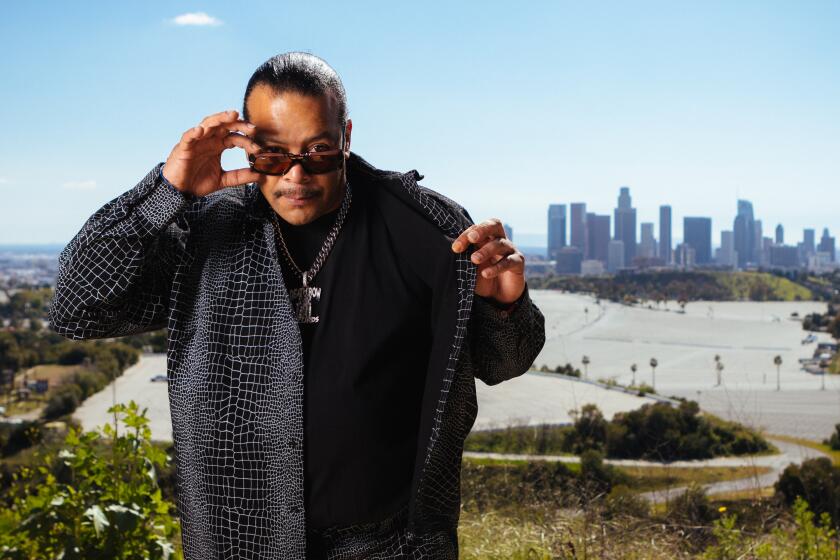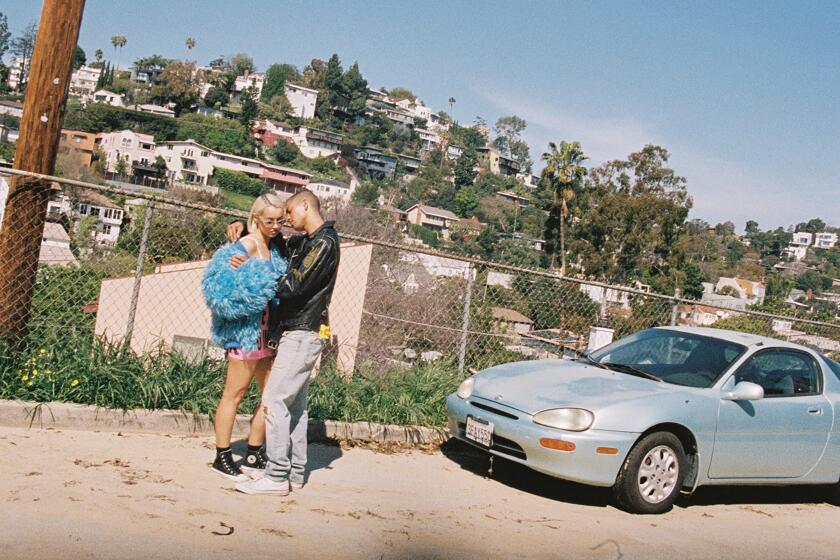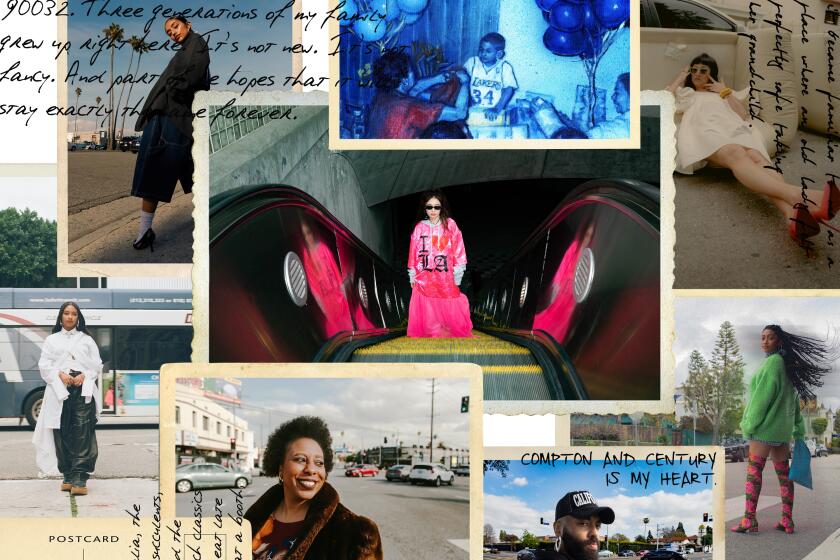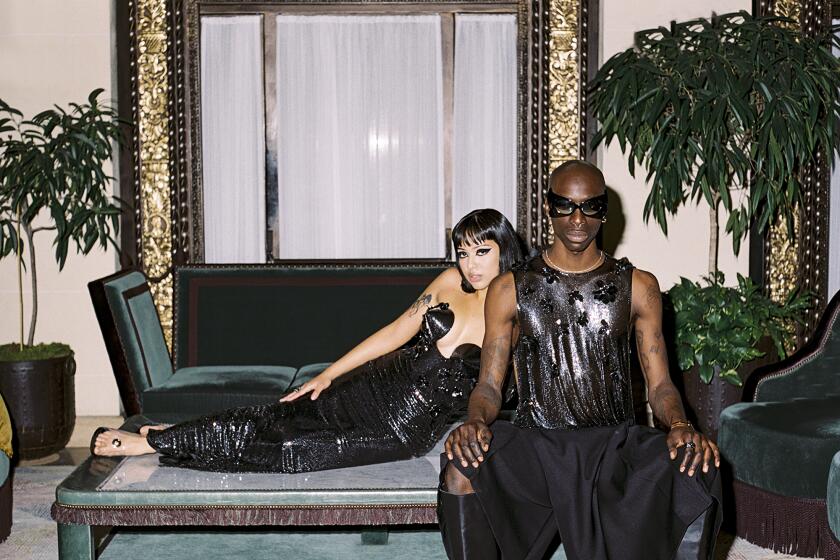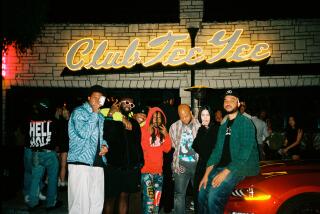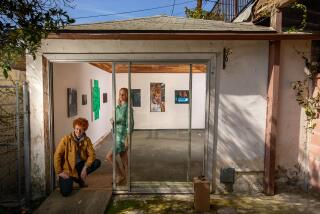- Share via

This story is part of Image issue 18, “Mission,” an anthology of fantastic voyages — from L.A. to the world and back to the epicenter. Read the whole issue here.
Everyone in Los Angeles has heard the phrase “location, location, location” tossed about, right? As a film student in the ’90s at UCLA, my peers and I definitely placed a premium on finding just the right place to shoot our scenes. In retrospect, I think this urban surveying is what made me fall so hard in love with Los Angeles back then and what pulled me back here now. After COVID, I feel like I am learning the city all over again. My way of learning about a place as an artist and as a citizen always involves studying other artists who cut deep grooves into the city lore. Wanda Coleman is such a figure. Reading her poems is like being led by the hand through the streets of Los Angeles. From Venice to South Los Angeles to Hollywood, Coleman, who died at age 67 in 2013, drew a map with cautions and songs and screeds unlike anything I’ve read. So when I learned from my student AK Jenkins (soon to be a CalArts alumn) that Coleman’s brother George Evans (Coleman was born Wanda Evans) was still in L.A., I jumped at the chance to meet with him.
Evans, age 74, is a wonderful and interesting artist in his own right and a crucial link that intersects several cultural histories of Los Angeles — from Beat poetry to Hollywood movies, from grassroots arts organizations to Black skin magazines, from Charles White to Edgar Arcenaux. These intersections, coincidences and connections weaving through Evans’ life speak to the immense contributions of the Black citizens of Los Angeles, many of whom come from working-class roots (see: “Drylongso”). People who did extraordinary things with very little. George Evans and his sister Wanda Coleman are Los Angeles treasures.
After half a century of hard living and hustle, the flamboyant storyteller from Pomona is learning to live with regrets and find peace.
As a native Northern Californian who enjoyed many family road trips down to L.A. to visit cousins in Carson, I really revel in the affinities and overlaps between George’s experience growing up in this state and my own. We may be separated by a generation, but we definitely share a kind of Black West Coast culture — all the way down to art heroes, like the painter Nathan Oliveira. Sun Ra insists that there is no such thing as a coincidence. I tend to agree. We are linked through a history of Black Californian creatives, and through Evans, my understanding of the history of Black Los Angeles and its contributions to the greater L.A. have colorfully deepened.
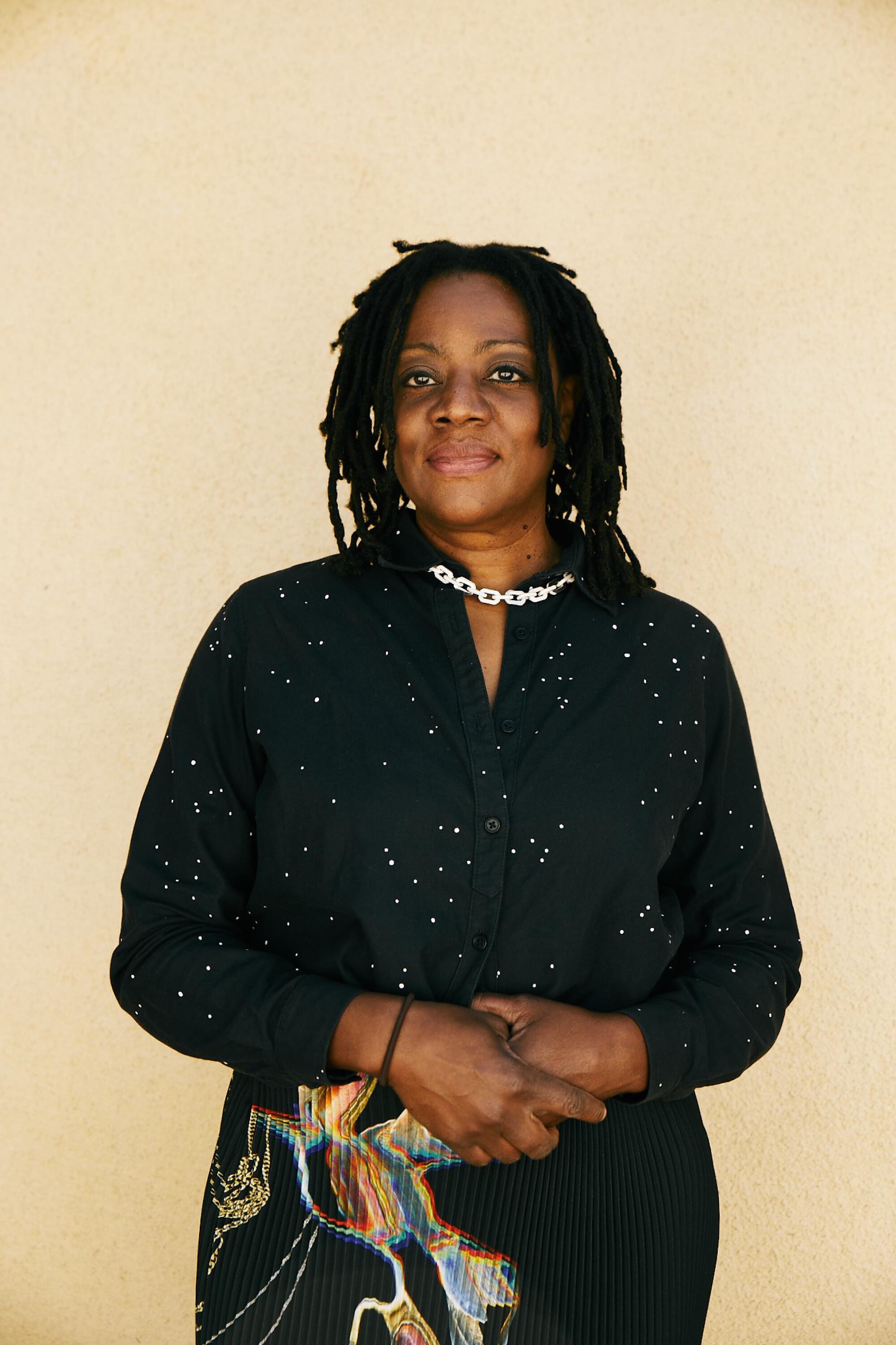
Cauleen Smith: My dad recently gave me this catalog that’s from Golden State Mutual Life Insurance Co. It’s a catalog about Black jazz masters, and I kept it because it has this one photograph that I just thought was amazing.
George Evans: You know, when I graduated from Chouinard, I worked for Golden State Mutual Life Insurance Co. doing graphic design. A lot of the art collection from their history is at CAAM [California African American Museum]. There are two murals inside of the building [by Hale Woodruff and Charles Alston], and the building itself is a historical landmark [designed by Paul R. Williams]. Golden State Mutual Life Insurance Co. was across this country — they had offices in Chicago, in Atlanta, in Texas. They were national. And they were really an institution that trained people. They had to build their own workforce. So the uniqueness of that company was —
CS: And then also collecting art!
GE: One of the founders of GSM was William [Bill] Nickerson. He used the office spaces for galleries. So from the first floor going up he would take somebody’s artwork and he would hang it. He did the whole building. He used the building as a showcase and would give tours. Across the street, on the adjacent corner is Hobart, and when you cross Adams there is an old fire station. That was Wendell Collins’ print shop. He was a master printer. Collins was the printmaker for Samella Lewis and [Elizabeth] Catlett, who was Charles White’s wife.
CS: First wife. And then she moved to Mexico.
GE: Yes, and she married Francisco Mora.
The [Golden Mutual] Life Insurance Co. was started by William Nickerson, George A. Beavers Jr. and Norman O. Houston. Matter of fact, if you are going over Stocker and Overhill in that area, there’s a Norman O. Houston Park and that’s the Norman O. Houston of Golden Mutual. They started that company. It started on Central Avenue, and that’s when I believe my father was working for them. My father really wanted to be a publisher. He acquired some presses, but his partner stole them.
CS: I read that.
GE: So then my father did more signage after that. But to me this is still impressive [George hands Cauleen a publication made by George Sr.]; I like to look at this every once in a while. When you look at that it says “George Evans art director.” So my father knew what he wanted to accomplish. He organized all the barbershops in South-Central where he distributed that publication. My father was an advertising man. His shop was Evans and Sons Advertising, and all four of us had to work there. [Laughs] I did the most.
CS: This leads me to the most amazing thing of Wanda editing Players magazine — the first six issues — which I thought was incredible. But now, learning about her background, it makes total sense that she would know how to run a magazine.
GE: My father was a builder. I mean, he contributed so much to this city. There are three of us left. My younger brother, Marvin; he’s a musician. My youngest sister, Sharon; she’s in her 60s now, and she’s a musician. Wanda was the oldest. I’m the second.
CS: You know, the way in which I wanted to work with Wanda Coleman’s work was through music, because so many of her poems are songs. Of what I could find on YouTube, I never really saw her sing, but she’s such a powerful performer.
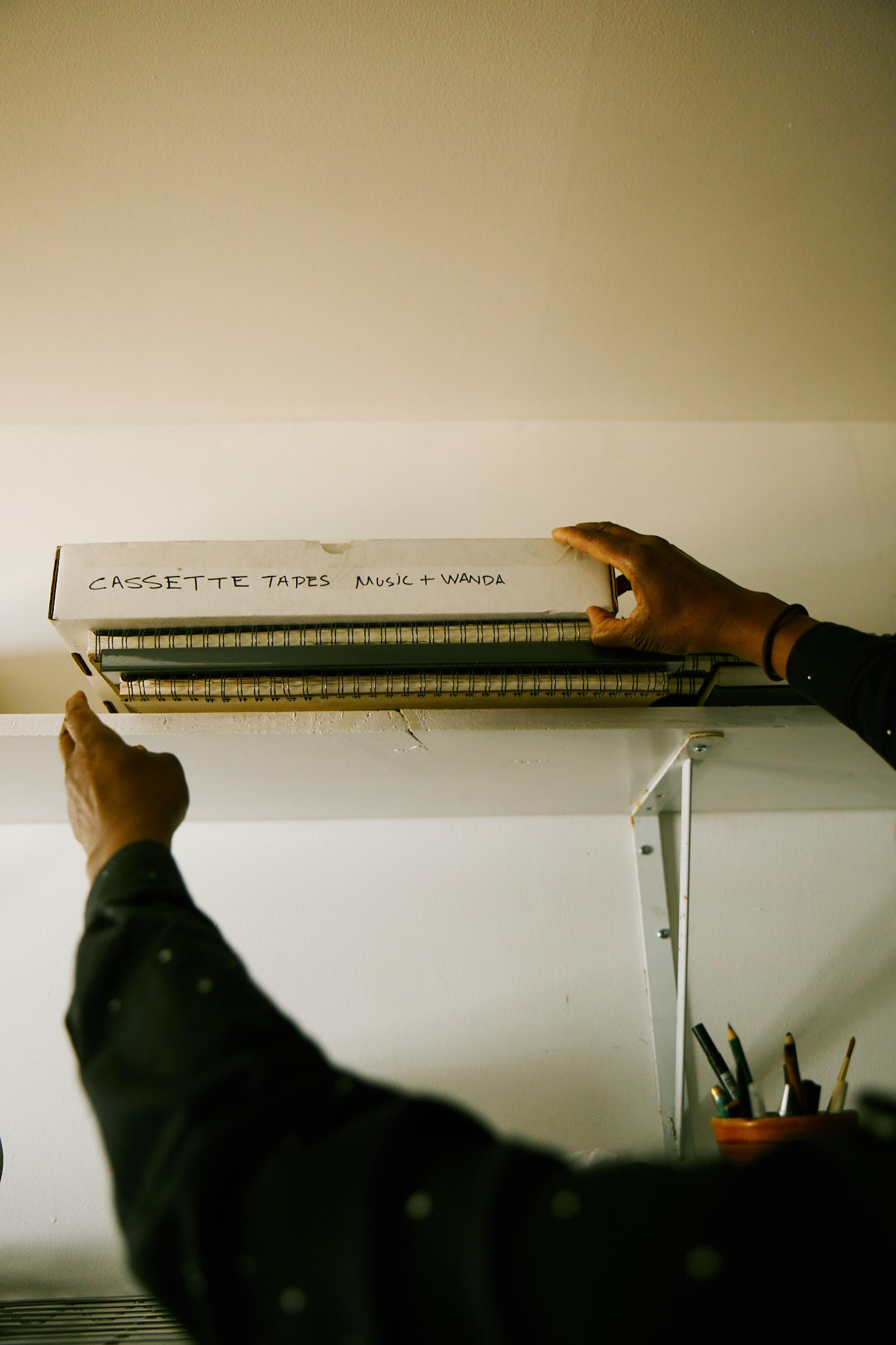
GE: Marvin used to play with her. She would have Marvin come and bring the sounds.
CS: He would play while she’s reading?
GE: Mm-hmm. They would collaborate.
My parents had classical music in the house. And when I think back on it, I think that came from the Reagans. You know, my mother did domestic work for the Reagans.
CS: I read about that.
GE: Because my mother came from Oklahoma; [she liked] Charley Pride. She also listened to R&B and listened to KGFJ. My father was definitely rhythm and blues.
CS: I really related to that part of Wanda’s book “The Riot Inside Me” because my mom does not listen to the blues — I only heard it when she was not in the house. My dad would play the records. [laughs] You know, Mom likes the cool jazz vibe.
GE: I still remember when my father brought home “Blueberry Hill” by Fats Domino at Christmas. We were peeping through the hallway, and they were in the front room and they were dancing together. You know, when you think of these little beautiful times with family. That was one of them.
CS: That’s a really nice memory.
I feel like those blues songs in Wanda’s collections are really intriguing to me. She kind of tried every form: There are sonnets, poems that are sort of like haiku, everything. But the blues songs stand out. I’m wondering why didn’t she ever just record these. I can almost hear them.
GE: In high school we all had to do music. I did piano, my brother kept it up, Wanda did piano and then she did violin. We had all of these records stashed under the cabinet. We had Sibelius, Prokofiev, Beethoven. Wanda was all into that. I would be doing Marvin Gaye, James Brown. She would be playing this classical music and it would make me mad.
CS: [Laughs] Why?
GE: We were all four of us in the same room. And she would be playing something that I didn’t want to hear, and I was trying to listen to my music. I would tell her turn it down, and she wouldn’t do it. [Laughs] We’d go back and forth.
When my mother would take us on a drive somewhere, Wanda was always reading, and me, I was always looking out the window.
CS: You were a visual person, and she was a literary person.
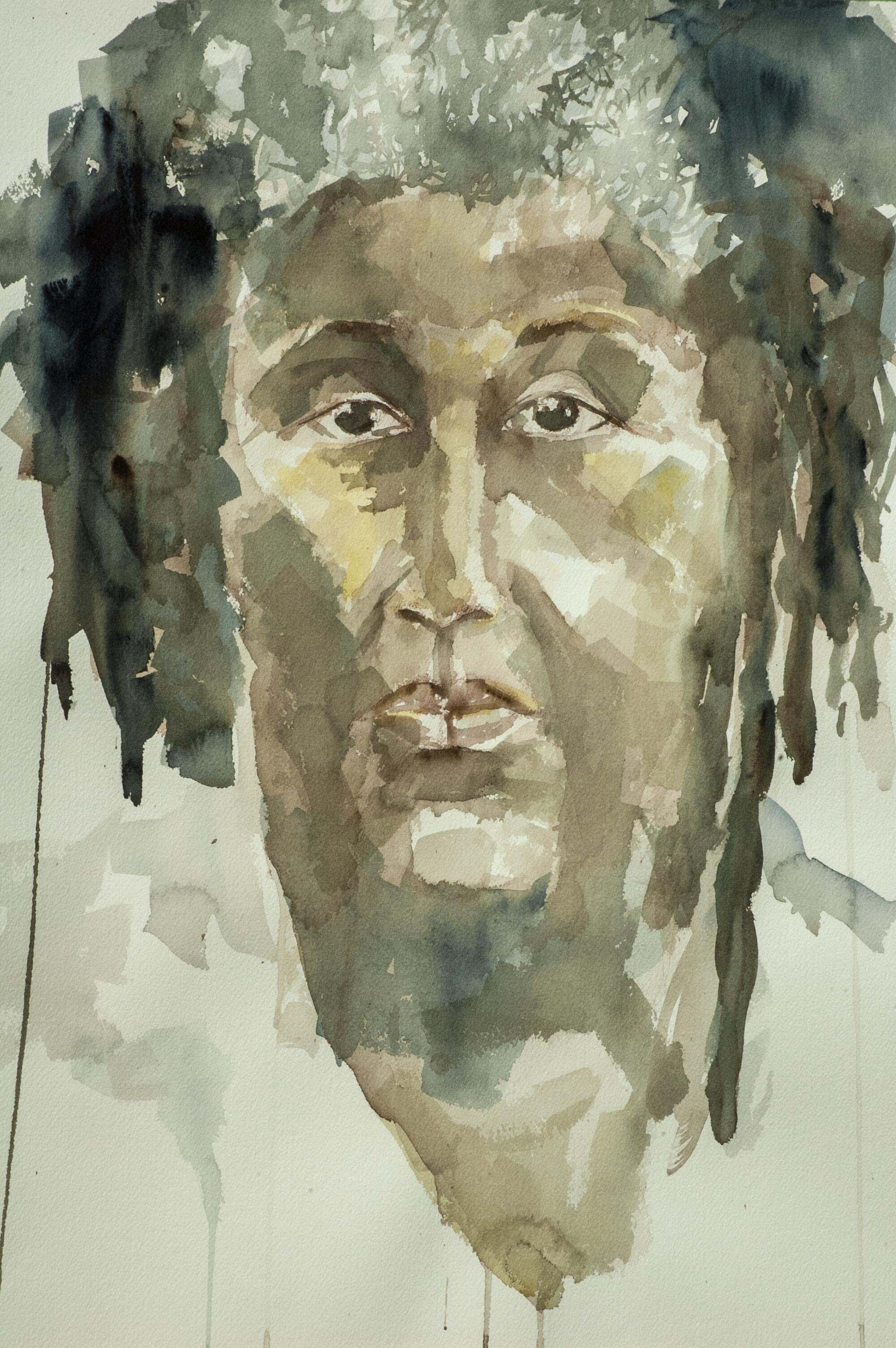
GE: I was doing art class, I was drawing.
I started a Sunday afternoon drawing class at Studio Watts. Studio Watts came out of the riots. You had Watts Writers Workshop with [Budd] Schulberg. The [Watts] Towers Arts Center was not there yet. Wanda was working between Budd Schulberg and Studio Watts; she was all over the place. She was just really assertive. She went for it. You know the way we were raised was, you gotta stay alive and try not to stand out too much. But she really went for it, she excelled.
I also was becoming of an age where I was starting to want to spread my wings. And there was this hippie-looking young lady who was at Trade-Tech [Los Angeles Trade Technical College], and we kind of befriended each other. She lived in Echo Park, and I was looking to get out. She said, “If my old man likes you, you can live in the basement.” And this big, burly, bearded white guy walks in. He says, “Yeah, you can live in the basement. You gotta clean it up, though, make it livable. You can have it and you don’t have to pay any rent.” So I left home and bolted into that.
From Marni X No Vacancy Inn’s latest collab to Ryan Preciado’s first solo exhibition at Matthew Brown Gallery, the Drip Index can get you active this spring.
CS: That’s where Wanda would come and see you.
GE: Mm-hmm. I was going to Chouinard [subsequently merged into CalArts] and living in Echo Park. [Before I enrolled at Chouinard, I was already] familiar because if I didn’t have money, we would go to the campus, and we would take our sketchbooks and the teachers would just let you sit in. “Yeah, come on in, you can draw.” So we would fill sketchbooks. And those sketchbooks are what got me a scholarship [to Chouinard].
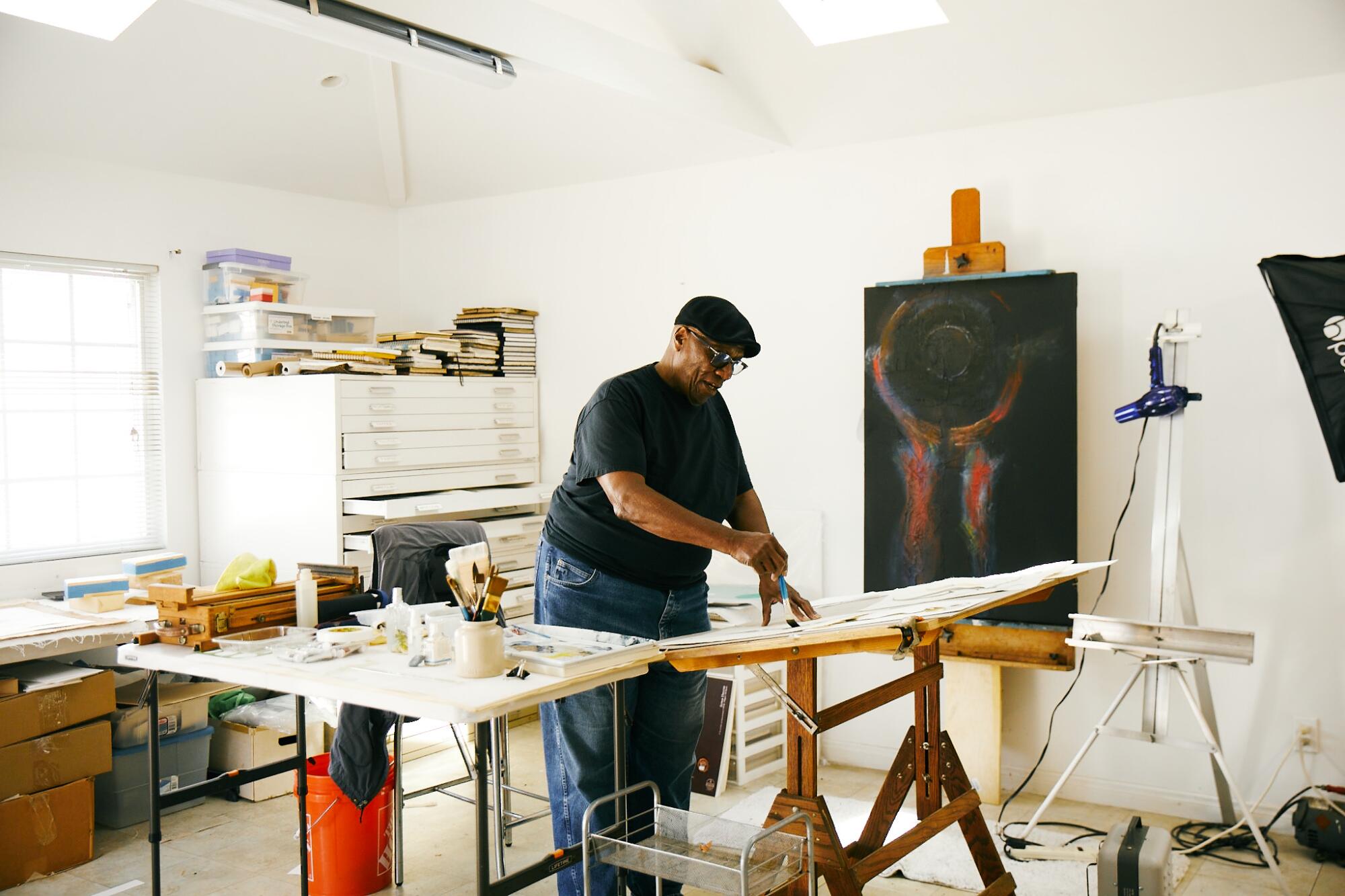
I always liked abstract painting. That’s why when I started at Chouinard, I went in there the first day and changed my major to painting. I thought, “At least I can paint for four years, and then I’ll figure it out from there.” In Echo Park, you had Paul Vangelisti who published [Charles] Bukowski, who lived on the other side of the hill. There were a number of the Beatnik poets. I would hang out late nights with John Thomas and Bukowksi, all these poets — these guys having these philosophical discussions. It was deep!
CS: What was that like? Were you just soaking it in? That’s incredible, because you knew who Charles Bukowski was, right?
GE: This was before he was well known. Hanging out with them — it did something to me that made it easier for me [to get] a sense of what was outside of our culture, so to speak. [There was a] mystique of being in Echo Park. John Thomas was doing my homework for me! [Laughs] [I was] really learning how poetry is an art form. I liked poetry — poetry saved my butt in high school. I think I was looking at my sister; poetry was one of the things that I could grasp. So all of a sudden, here I am with these Beatnik poets and getting the lessons from Big John. Wanda would come up and John started critiquing her writings. I remember when John turned her on to Black Sparrow Press. John thought that her writings were very good, so he encouraged her to keep going. She was really hustling.
CS: A single mom with three kids — that alone is just a hustle. But she also wrote for “Days of our Lives,” and then that producer got fired, so all the writers got fired.
GE: But that got her an Emmy. She was putting all these irons in the fire and out busting to make things happen. She would do some readings over here, then go over here and do some writings. She had the kids over here. There were times that, some of her taste in men …
CS: You did not agree.
GE: Uh, no. [Laughs] From her first one, Jerry [Coleman] —
CS: He was the white man who was very entrenched in the civil rights movement, right?
GE: Yeah, he was a Freedom Rider. Wanda was meeting a lot of people. She had graduated high school, she had left Freemont, and she was looking at going to Cal State L.A. But she was involved in a lot of the civil rights movement. You had Ron [now Maulana] Karenga, all of that stuff was happening. She was actively trying to get her career going. She was working with Anna Halprin [the choreographer]. That was the time [the two of us] were at the Watts Studio, so we were kind of coordinating with each other. Home was where we would get together on holidays. I stayed with her for a couple of weeks before I moved to Echo Park.
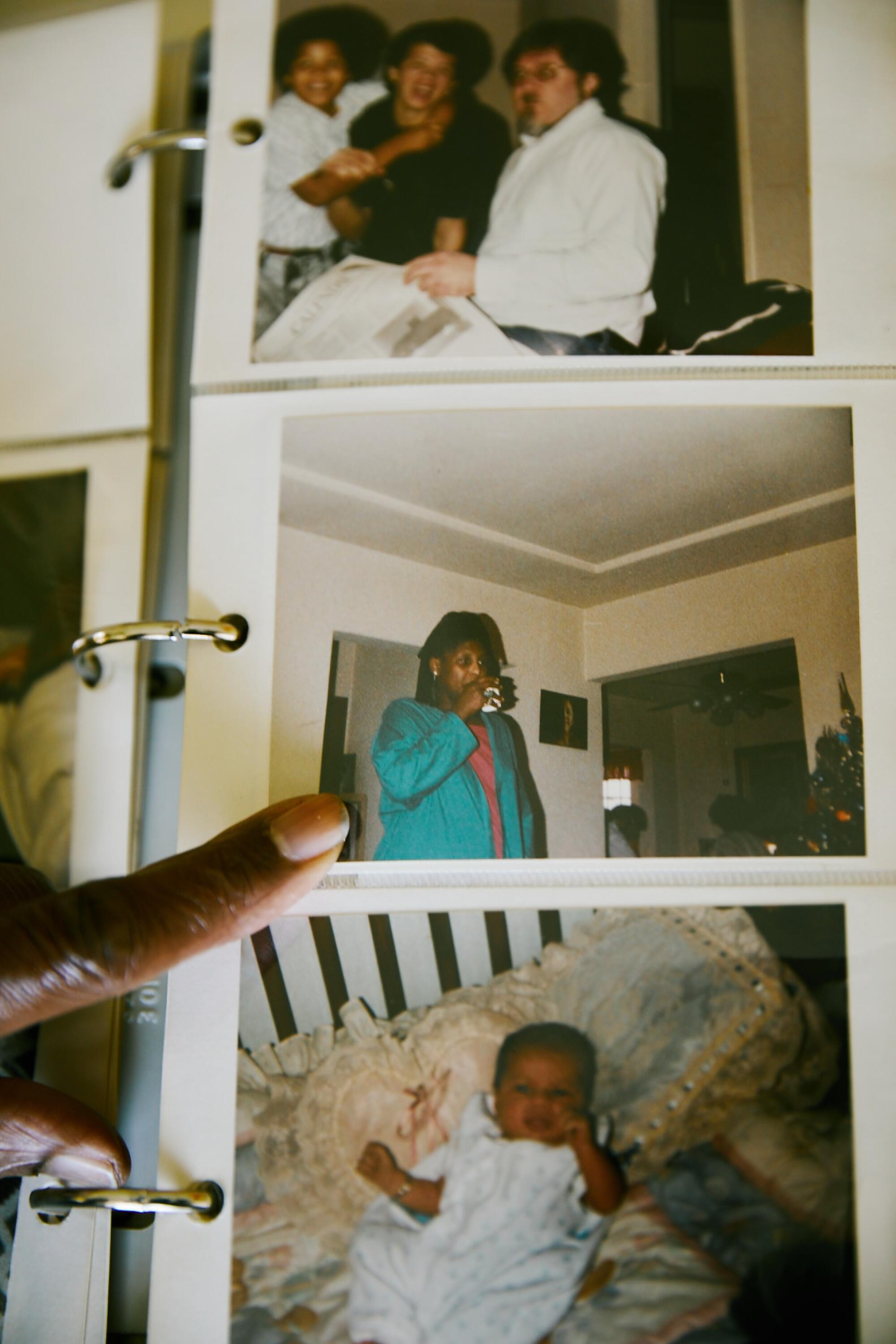
CS: Was that before or after she met her first husband?
GE: That’s after — Jerry was gone. [It was] the ’80s. That was when I started shooting, and when [Wanda] got that position at Players. She gave me enough assignments that I took that money and bought a house [on the border of Highland Park and Eagle Rock]. We were always helping each other out.
CS: Did you ever go to any of her poetry readings?
GE: Yeah, I went to a lot of them.
CS: She had such a specific style. When I see her on YouTube, I’m like, “Wow, she’s so intense.”
GE: [Laughs] It was always her energy. That’s who she was. She was more open to just going out there and doing it, and that started in high school. She would go off on these different speech oratories. She was always reading; she was always researching. I would be looking at pictures or drawing something, and she would be reading, she would be writing. Wanda one day came home and said [to me], “They’re starting Studio Watts and they’re looking for artists and you need to go and see.” So I went over and met Jim Woods, the director, and another woman [Jayne Cortez] was also running it. [So that’s how] I started a Sunday afternoon drawing class at Studio Watts.
CS: Where was the house that you guys grew up in?
GE: On 89th between Avalon and Central. I went past there about a week ago and I couldn’t find it. It’s still there, but the street had changed so much. I drove right past it. We grew up [in] South-Central, but after the Watts riots, the whole area became Watts. We really saw the migration of the community changing from the working class to a poor [one] — after 1956, it became a ghetto.
CS: How old were you when the riots happened?
GE: Seventeen. Me and my dad were working through that. My father would not stop because he had to work. They had the perimeters set up. We would work within the perimeters, but if we needed to go out, we would go out, and then come right back in. On 103rd Street, we were doing an architectural rendering for a medical building on one end of the street — we were the east end — and on the west end, people were setting it on fire. And that’s actually where I first encountered Noah Purifoy. He was collecting bottles and stuff. He had this bottle, it was a Coke bottle, and it was melted. I was like, man, that’s fascinating. I was walking around, just looking out of curiosity, and seeing him collecting things.
And then [I met] Cecil Fergerson. Cecil lived on 89th Street. He lived on the next block up from our house. He knew pretty much everybody in the neighborhood. And Cecil started with LACMA when it was in Exposition Park, worked his way up [from custodian] to associate curator, and he started putting together shows in Watts and South Central. You know, as a Black artist, you didn’t have any place to show. So he produced a lot of shows — he’s actually how I got into teaching at LACMA. He opened up a lot of doors.
CS: Yeah, for a lot of people. I’m still blown away by you just meeting Noah Purifoy picking up trash and him showing you melted bottles.
GE: I was getting snippets of art happening outside of my reality. In high school you weren’t supposed to be an artist because you can’t make a living. It never settled with me because I’m watching my father as a sign painter making a living with his art. For me, it was a natural thing to kind of say, well, if I go this way, I’ll make a living with my art too. Tutor Arts at the time was primarily about taking artists from different parts of society and putting us together. It was Charlie’s idea.
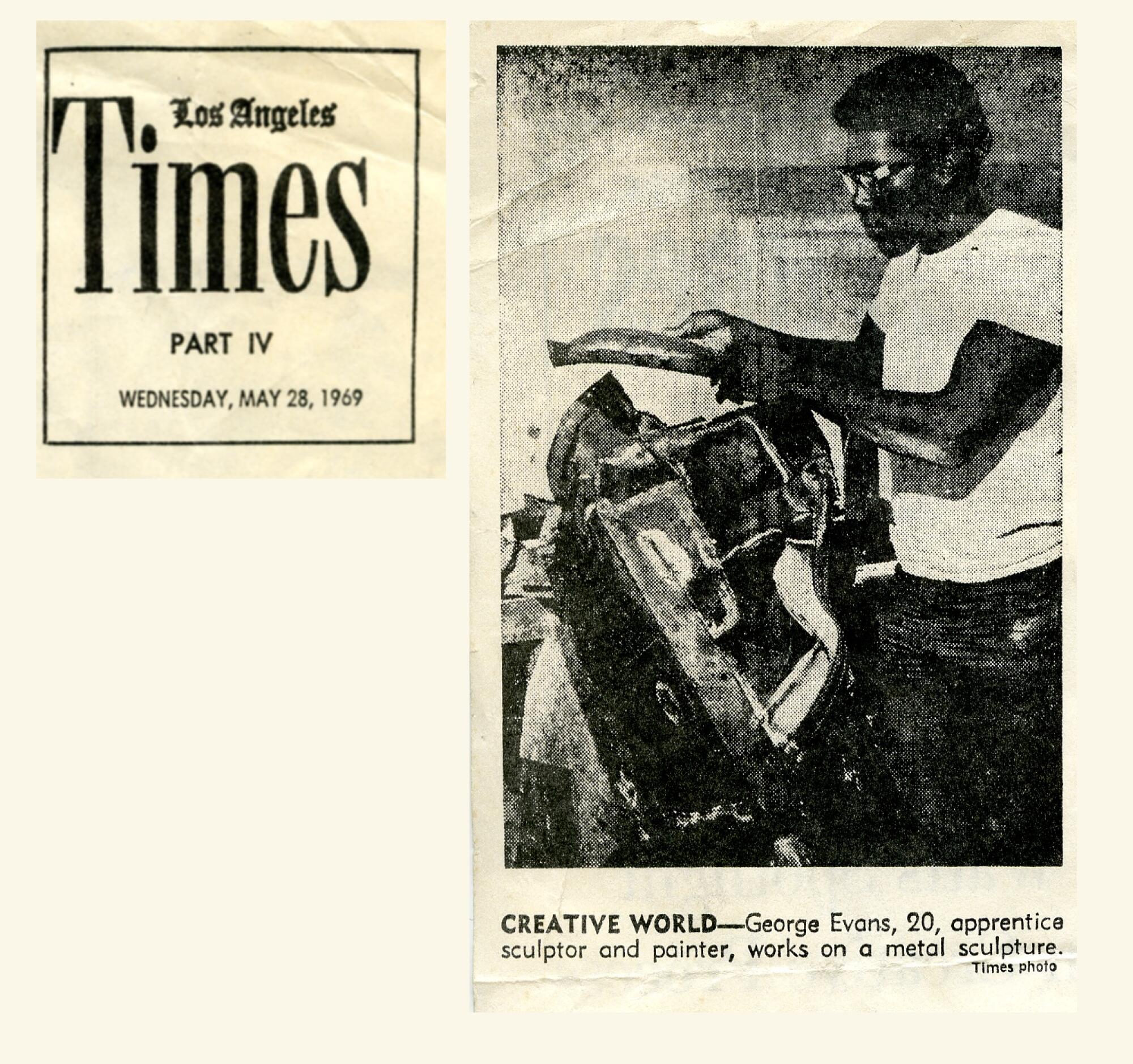
CS: Charles White.
GE: Charles White. And it was Bill Tara who introduced [White] to William Pajaud, who was public relations director at GSM, and that created the chemistry for Tutor Arts. Then Tutor Arts moved to Chouinard, and that’s when I came into the program. Then they moved to Otis, which is now the Charles White Elementary School [in MacArthur Park]. When Charlie passed on and Bill Tara passed away, I had graduated and I was working at GSM. Several of the artists tried to keep Tutor Arts going, but it ended up closing in the late ’70s. But Kerry Marshall is Tutor Arts.
CS: Kerry James Marshall? As a student or as a teacher?
GE: As a student! So is Mark Greenfield — he’s Tutor Arts. We still have alumni.
CS: When you were kids, did you guys play at the Watts Towers ever?
GE: We used to go to the tower. It was just there — you could climb over the wall. It looked like a big ship. We would either walk from our house to Watts or we would take the streetcar. It was just kind of there. It wasn’t until after the riots that it became kind of —
CS: Special.
GE: Yeah.
CS: I love the idea of it being so public, because now there’s a fence around it. And you’re not even allowed to spend time in there. You have to be toured through, like they shove you through.
I admire your generation. You put up with stuff that I cannot fathom — as artists, as professionals, living in this particular city.
GE: The difference to me between here and the South, discrimination here is more …
CS: Wanda nailed it. She called L.A. the Deep West — that’s just ringing in my head. That is it. This is just like the South, only it has a veneer. I feel like Black people are being pushed out of L.A.
GE: They are. I think the late ’70s is when things turned sour, when you start having Crips and Bloods that came out of Reaganomics. Growing up here, going to high school, I had to cross gang turf. That was a challenge. It was my father that really made the difference.
CS: Keeping you focused.
GE: Yeah. My father had my best interest.
I followed exactly in my dad’s footsteps. My dad could airbrush, I airbrushed. He could take a picture, I took a picture. Just about everything that he did I walked exactly in his footprints. Art saved me. It took me outside of the area. Me and Wanda always worked kind of in conjunction — she would need something and I would photograph it for her or draw it for her. We would do things together.
Cauleen Smith is an interdisciplinary artist whose work reflects upon the everyday possibilities of the imagination.
